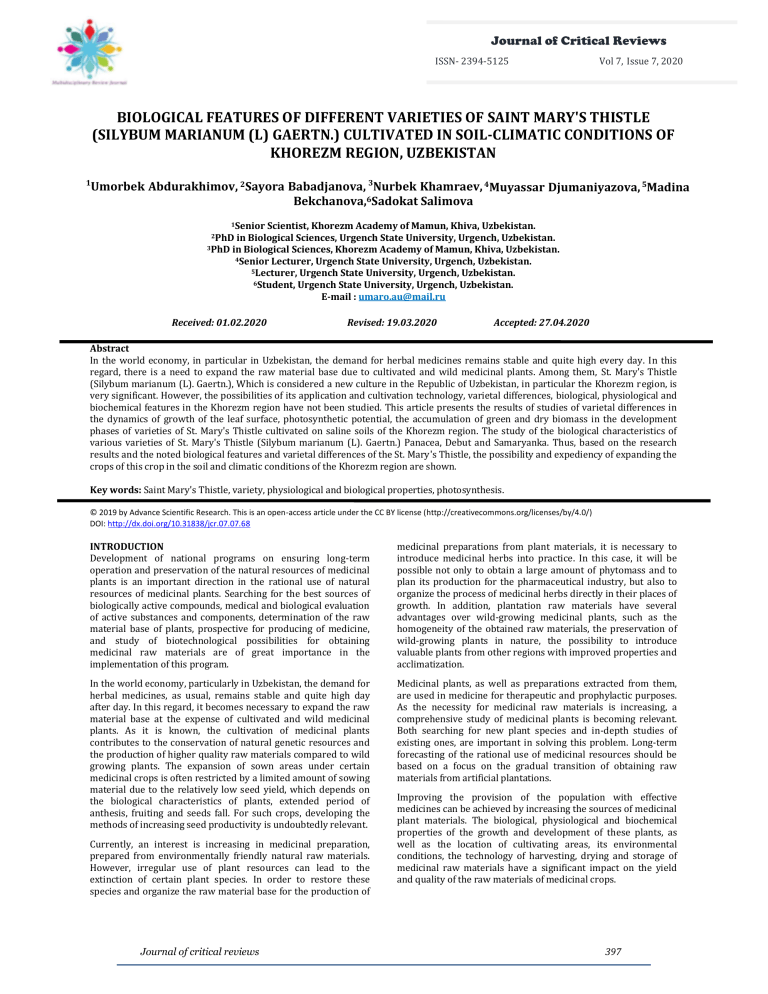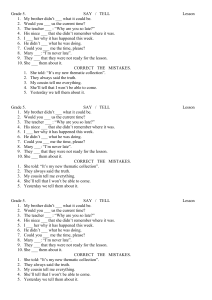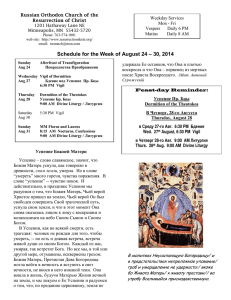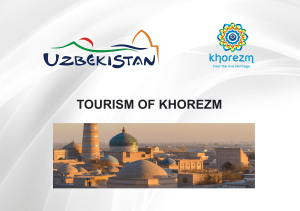
Journal of Critical Reviews ISSN- 2394-5125 Vol 7, Issue 7, 2020 BIOLOGICAL FEATURES OF DIFFERENT VARIETIES OF SAINT MARY'S THISTLE (SILYBUM MARIANUM (L) GAERTN.) CULTIVATED IN SOIL-CLIMATIC CONDITIONS OF KHOREZM REGION, UZBEKISTAN 1 Umorbek Abdurakhimov, 2Sayora Babadjanova, 3Nurbek Khamraev, 4Muyassar Djumaniyazova, 5Madina Bekchanova,6Sadokat Salimova 1Senior Scientist, Khorezm Academy of Mamun, Khiva, Uzbekistan. 2PhD in Biological Sciences, Urgench State University, Urgench, Uzbekistan. 3PhD in Biological Sciences, Khorezm Academy of Mamun, Khiva, Uzbekistan. 4Senior Lecturer, Urgench State University, Urgench, Uzbekistan. 5Lecturer, Urgench State University, Urgench, Uzbekistan. 6Student, Urgench State University, Urgench, Uzbekistan. E-mail : umaro.au@mail.ru Received: 01.02.2020 Revised: 19.03.2020 Accepted: 27.04.2020 Abstract In the world economy, in particular in Uzbekistan, the demand for herbal medicines remains stable and quite high every day. In this regard, there is a need to expand the raw material base due to cultivated and wild medicinal plants. Among them, St. Mary's Thistle (Silybum marianum (L). Gaertn.), Which is considered a new culture in the Republic of Uzbekistan, in particular the Khorezm region, is very significant. However, the possibilities of its application and cultivation technology, varietal differences, biological, physiological and biochemical features in the Khorezm region have not been studied. This article presents the results of studies of varietal differences in the dynamics of growth of the leaf surface, photosynthetic potential, the accumulation of green and dry biomass in the development phases of varieties of St. Mary's Thistle cultivated on saline soils of the Khorezm region. The study of the biological characteristics of various varieties of St. Mary's Thistle (Silybum marianum (L). Gaertn.) Panacea, Debut and Samaryanka. Thus, based on the research results and the noted biological features and varietal differences of the St. Mary's Thistle, the possibility and expediency of expanding the crops of this crop in the soil and climatic conditions of the Khorezm region are shown. Key words: Saint Mary's Thistle, variety, physiological and biological properties, photosynthesis. © 2019 by Advance Scientific Research. This is an open-access article under the CC BY license (http://creativecommons.org/licenses/by/4.0/) DOI: http://dx.doi.org/10.31838/jcr.07.07.68 INTRODUCTION Development of national programs on ensuring long-term operation and preservation of the natural resources of medicinal plants is an important direction in the rational use of natural resources of medicinal plants. Searching for the best sources of biologically active compounds, medical and biological evaluation of active substances and components, determination of the raw material base of plants, prospective for producing of medicine, and study of biotechnological possibilities for obtaining medicinal raw materials are of great importance in the implementation of this program. medicinal preparations from plant materials, it is necessary to introduce medicinal herbs into practice. In this case, it will be possible not only to obtain a large amount of phytomass and to plan its production for the pharmaceutical industry, but also to organize the process of medicinal herbs directly in their places of growth. In addition, plantation raw materials have several advantages over wild-growing medicinal plants, such as the homogeneity of the obtained raw materials, the preservation of wild-growing plants in nature, the possibility to introduce valuable plants from other regions with improved properties and acclimatization. In the world economy, particularly in Uzbekistan, the demand for herbal medicines, as usual, remains stable and quite high day after day. In this regard, it becomes necessary to expand the raw material base at the expense of cultivated and wild medicinal plants. As it is known, the cultivation of medicinal plants contributes to the conservation of natural genetic resources and the production of higher quality raw materials compared to wild growing plants. The expansion of sown areas under certain medicinal crops is often restricted by a limited amount of sowing material due to the relatively low seed yield, which depends on the biological characteristics of plants, extended period of anthesis, fruiting and seeds fall. For such crops, developing the methods of increasing seed productivity is undoubtedly relevant. Medicinal plants, as well as preparations extracted from them, are used in medicine for therapeutic and prophylactic purposes. As the necessity for medicinal raw materials is increasing, a comprehensive study of medicinal plants is becoming relevant. Both searching for new plant species and in-depth studies of existing ones, are important in solving this problem. Long-term forecasting of the rational use of medicinal resources should be based on a focus on the gradual transition of obtaining raw materials from artificial plantations. Currently, an interest is increasing in medicinal preparation, prepared from environmentally friendly natural raw materials. However, irregular use of plant resources can lead to the extinction of certain plant species. In order to restore these species and organize the raw material base for the production of Journal of critical reviews Improving the provision of the population with effective medicines can be achieved by increasing the sources of medicinal plant materials. The biological, physiological and biochemical properties of the growth and development of these plants, as well as the location of cultivating areas, its environmental conditions, the technology of harvesting, drying and storage of medicinal raw materials have a significant impact on the yield and quality of the raw materials of medicinal crops. 397 BIOLOGICAL FEATURES OF DIFFERENT VARIETIES OF SAINT MARY'S THISTLE (SILYBUM MARIANUM (L) GAERTN.) CULTIVATED IN SOIL-CLIMATIC CONDITIONS OF KHOREZM REGION, UZBEKISTAN It is well known, that the development of the technology of cultivating any crops should be based on the results of scientific research, aimed at searching optimal solutions to increase crop productivity with high quality and produce environmentally safe products. Experimental studies on plant biology, the economic assessment of individual species and forms in order to select the most promising ones for introduction and correct regionalization take on special topicality. Development of the techniques of cultivating plants, including the whole range of agricultural activities, with effective methods of growing and breeding medicinal plants, studying yield and productivity, as well as determining their resistance to diseases and pests is of great importance. Therefore, special attention should be paid to the development of methods for cultivating and breeding high-productive, economically valuable types of medicinal plants, for the purpose of creating large-scale plantations on saline soils of Khorezm region. St. Mary's Thistle (Silybum marianum), which is considered a new culture in the Republic of Uzbekistan, particularly in Khorezm region, is very important among them. However, the possibility of its application and cultivation technology, varietal differences, biological, physiological and biochemical properties in Khorezm region have not been studied. According to the schedule of the applied research project “Cultivation of medicinal plants in Khorezm region and extraction of biologically active additives on their basis”, in Khorezm Mamun academy research works are carried out to study varietal differences, biological, physiological and biochemical properties of St. Mary's Thistle cultivated on saline soil-climatic conditions of Khorezm region. MATERIAL AND METHODS The goal of our research is to study the biological characteristics of different varieties of St. Mary's Thistle (Silybum marianum L.) as Panacea, Debut and Samaryanka on alluvial meadow soils of Khorezm region. The studies were conducted at the experimental base of Khorezm Mamun academy in Khiva district of Khorezm region. The soils of the study area, where the experiments were carried out, are alluvial-meadow and these soils make up 14.2% of the total cultivated area of Khorezm region in the lower the Amu Darya territory. They were formed in conditions of the modern delta. Groundwater is mineralized, occurring at a depth of 1-3 m. According to the agrochemical properties, the soil is characterized by ubiquitous carbonate content, weak texture, low humus content and a strong tendency to salinization. The soil is mainly medium saline with chloride-sulfate. The researches were carried out mainly on small-scale experimental areas (from 1 to 10 m2) in total 200 m2 area. When studying the seasonal rhythm of the development according to the generally accepted methods, we observed the onset period of the main phases of plant development. The processing of phenological dates was carried out according to the recommendations, taking into account the additions of [V.N. Nilova, 1980]. Laboratory experiments on the determination of germinating capacity were carried out according to the method of [S.S. Lishuk, 1991]. For this 25-100 seeds were examined in 3- Journal of critical reviews 4 replications [Zorina, Kabanova, 1987]. Types of seed emergence were determined by the methods of sprouting, seed productivity was studied according to the generally accepted methods [Vainagy, 1985]. The arrangement of variants and replications was in consecutive order in one or two tiers. The plant density was determined twice after germination and during harvesting by counting plants in all variations. Phenological observations, measuring the leaf area and productivity of photosynthesis, dynamics of biomass accumulation, selection of plant and soil samples at the time of harvesting, analysis of the crop structure was carried out by determining the mass of 1000 seeds according to State Standard – 10842-76. Statistical data processing was carried out by the method of variance and correlation-regression analyzes [B. A. Dospekhov, 1985]. Agricultural technology in the experiments was performed by generally accepted methods. Sowing in 2019 was carried out on April 17. Immediately after sowing, the plots were irrigated. Before sowing, mineral fertilizer (ammophos) was applied at a rate of 90 kg per hectare. RESULTS AND DISCUSSION The soil and climatic conditions of Khorezm region are quite favorable in environmental and economic respects for the cultivation of a perspective non-traditional medicinal crop – St. Mary's Thistle. Therefore, the main task of our research is to study the characteristics of growth and development and varietal differences of this plant. The most complete realization of the bioclimatic potential of the culture zone can be achieved only with the use of such technologies, each of which meets the biological requirements of the culture. The main indicators characterizing the biological properties of medicinal plants are, first of all, the growth of the top and roots, the dynamics of the accumulation of dry matter, leaf formation and biochemical parameters. In this aspect, it is obvious that, the leaf area index, the content of leaves in the crop and the productivity of photosynthesis should also be considered [N.A.Lvov, S.A.Yakovleva, 1970]. As is known, the photosynthetic rate, which significantly depends on the assimilating surface of the leaves, affects on the amount of yield. In particular, there is an optimal total leaf area for St. Mary's Thistle, at which this crop gives the maximum yield. The leaf area may vary depending on the density of standing, methods of cultivation, agrometeorological conditions, etc. [A.S.Okanenko, 1954]. Besides the photosynthetic rate, the photosynthetic potential, the accumulation of green mass, dry matter and the net photosynthetic efficiency are also considered as the main indicators of the photosynthetic activity of plants Analysis of the obtained data showed that the size of the leaf area of the variety Panacea of St. Mary's Thistle at the first stages of development is insignificant and fluctuated from 0.68 to 1.17 thousand m2/ha in the phase of 3-4 leaves and from 1.87 to 2.05 thousand m2/ha in the phase of formation of tufts. In the variety Debut, it changed from 0.88 to 1.47 thousand m2/ha in the phase of 3-4 leaves and from 2.43 to 2.81 thousand m2/ha in the phase of formation of tufts and in the variety Samaryanka from 0.79 to 1.26 thousand m2/ha in the phase of 3-4 leaves and from 2.01 to 2.36 thousand m2/ha in the phase of formation of tufts (Table 1). 398 BIOLOGICAL FEATURES OF DIFFERENT VARIETIES OF SAINT MARY'S THISTLE (SILYBUM MARIANUM (L) GAERTN.) CULTIVATED IN SOIL-CLIMATIC CONDITIONS OF KHOREZM REGION, UZBEKISTAN Table 1The dynamics of growth of the leaf area (thousand m 2/ha) and photosynthetic potential (thousand m2/ha) according to the development phases of various varieties of St. Mary's Thistle 2018 2019 Average of 2018-2019 Development Photosyntheti Photosyntheti Photosyntheti phases Leaf area Leaf area Leaf area c potential c potential c potential Panacea 2-4 leaves 0,68 1,17 0,93 Formation of tufts 1,89 13,77 2,05 16,14 1,97 14,96 Budding 14,92 89,65 20,9 117,84 17,91 103,75 Initial blossom 25,78 216,58 29,76 259,43 27,77 238,01 Full blossom 30,45 286,35 33,88 338,42 32,17 312,39 Ripening 18,69 237,16 24,73 318,7 21,71 277,93 Debut 2-4 leaves 0,88 1,47 1,18 Formation of tufts 2,43 17,26 2,81 21,36 2,62 19,31 Budding 18,13 95,24 24,2 133,11 21,17 114,18 Initial blossom 30,05 226,76 33,74 276,83 31,90 251,80 Full blossom 33,61 306,51 40,18 362,57 36,90 334,54 Ripening 23,82 262,82 28,13 329,8 25,98 296,31 Samaryanka 2-4 leaves 0,79 1,26 1,03 Formation of tufts 2,01 15,11 2,36 17,84 2,19 16,48 Budding 16,05 91,78 21,8 123,72 18,93 107,75 Initial blossom 26,33 220,35 31,05 266,27 28,69 243,31 Full blossom 31,42 297,48 35,47 342,81 33,45 320,15 Ripening 20,15 245,34 25,32 323,4 22,74 284,37 Active growth of leaf area and increase of photosynthetic potential is observed in the budding phase of the all examined varieties of St. Mary's Thistle. In the variety Panacea, the average of leaf area index and photosynthetic potential increased to 17.91 and 103.75 thousand m2/ha, and in the phase formation of tufts it was 89.0% and 85.58% thousand m2/ha, respectively; in the variety Debut, the average of leaf area index and photosynthetic potential increased up to 21.17 and 114.18 thousand m2/ha, and in the phase formation of tufts it was 87.62% and 83.08% thousand m2/ha, respectively; in the variety Samaryanka the average of the indicators increased to 18.93 and 107.75 thousand m2/ha, and it was 88.43% and 84.7% in the phase formation of tufts. The maximum value of the leaf area index (Panacea – 32.17 thousand m2/ha, Debut – 36.90 thousand m2/ha and Samaryanka – 33.45 thousand m2/ha) and photosynthetic potential (Panacea – 312.39 thousand m2/ha, Debut – 334.54 thousand m2/ha and Samaryanka – 320.15 thousand m2/ha) were achieved in the phase of full bloom. Compared with the phase of budding, these indices in the Panacea were higher by 14.26 and 208.64 thousand m2/ha, which made up 33.2 – 55.6%, in Debut these indices were higher by 15.73 and 220.36 thousand m2/ha, which was 34.1-57.3%, and in Samaryanka, these indices were higher by 14.52 and 212.40 thousand m2/ha, and was 33.6-56.6 %. To the phase of ripening, in all examined varieties of St. Mary's Thistle, there was a gradual decrease in leaf area index and photosynthetic potential (Panacea – 21.77 and 277.93 thousand m2/ha, Debut – 25.98 and 296.31 thousand m2/ha, and Samaryanka – 22.74 and 284.37 thousand m2/ha) The main medicinal raw material of St. Mary's Thistle is its Journal of critical reviews blossom cluster, therefore, when cultivating this crop, it should be aimed at ensuring abundant flowering and increasing the amount and weight of flowers. In our experiments we have ascertained a direct relationship between the inflorescence yield and the intensity of formation of vegetative mass in the varieties of St. Mary's Thistle. At the beginning of the growing season, all of the studied varieties of St. Mary's Thistle had a weak root system and a small leaf surface. In the subsequent phases of the growing season, most of the organic matters were directed to the intensive formation of leafy mass. The accumulation of biomass in a large amount depended on the rate of formation of the leaf area. In our experiments, the following appropriateness was revealed: the faster the leaf area grew and the longer its activity was, the more active the accumulation of average daily growths happen, and the more green and dry biomass accumulated, respectively. A gradual accumulation of green mass and dry matter was observed at the beginning of the vegetation with sequential sharp increase in the flowering phase and a gradual decrease of the indicators as senescence of plants. Such a feature of growth in science is called ‘Growth curves of Sax’, which is expressed on the graph in the form of a single-vertex parabola of different flatness [Lyashenko Z.D., 1995]. The considered appropriateness in the formation of the leaf area led to similar principles in the accumulation of green mass and dry matter. Analysis of data on the dynamics of accumulation of green biomass allowed us to conclude that its accumulation also depends on the vegetation phase and differences in varieties (Table 2). 399 BIOLOGICAL FEATURES OF DIFFERENT VARIETIES OF SAINT MARY'S THISTLE (SILYBUM MARIANUM (L) GAERTN.) CULTIVATED IN SOIL-CLIMATIC CONDITIONS OF KHOREZM REGION, UZBEKISTAN Table 2The dynamics of the accumulation of green and dry biomass in various varieties of St. Mary's Thistle, t/ha, average for 2018-2019. The variety Panacea The variety Debut The variety Samaryanka Green Dry Green Dry Green Dry 1,27 11,56 24,36 34,71 40,94 25,87 0,33 1,42 2,4 3,08 3,78 4,26 1,72 15,81 30,75 37,15 46,19 33,78 0,57 1,7 3,07 3,76 4,81 5,76 1,43 13,34 26,12 35,40 42,85 30,94 0,42 1,62 2,81 3,39 4,12 4,83 Development phases 2-4 leaves Formation of tufts Budding Beginning of flowering Full bloom Ripening In the studied varieties of St. Mary's Thistle during the growing season, similarly to the leaf area, the photosynthetic potential also forms high indicators of green and dry biomass. However, in the early stages, these indicators are low. In the phase of formation of the tufts, in the variety Panacea it was 11.56 t/ha of green mass and 1.42 t/ha of dry matter, in the variety Debut it was 15.81 t/ha of green mass and 1.7 t/ha of dry matter, and in the variety Samaryanka it was 13.34 t/ha of green mass and 1.62 t/ha of dry matter, respectively. The most intense accumulation of vegetative mass was noted in the phase of full bloom. The mass formation of flowers and fruit ripening happened in this period. So, in the variety Panacea the maximum accumulation of green and dry biomass was observed - 40.94 and 3.78 t/ha, in the variety Debut - 46.19 and 4.81 t/ha, and in the variety Samaryanka - 42.85 and 4, 12 t/ha, respectively. Observations of the dynamics of the accumulation of green and dry biomass revealed a relationship between these indicators and differences of varieties in the period of formation of the vegetative mass. The largest amount of green biomass and dry matter was accumulated in the variety Debut (43.65 t/ha and 6.49 t/ha). CONCLUSIONS Based on the studies, the following conclusions can be drawn that, as a result of the researches, biological characteristics and varietal differences of the varieties of St. Mary's Thistle as Panacea, Debut and Samaryanka were revealed. There were significant differences on the growth and development rate, as well as, daily average growth depending on the development phases of the varieties. The varieties of St. Mary's Thistle have different rates of formation of the assimilation apparatus and photosynthetic potential. The maximum value of leaf area and photosynthetic potential in the variety Debut reached in the full bloom phase (36.90 and 334.54 thousand m2/ha). The accumulation of biomass in a large extent depended on the rate of formation of the leaf area. The maximum amount of green biomass is accumulated in the variety of Debut by the phase of full bloom (46.19 t/ha), and dry matter (4.81 t/ha) by the phase of fruit formation, when a significant number of leaves in the lower layer dry out. This appropriateness was observed within the all tested varieties of the St. Mary's Thistle in the all research years. Thus, based on the research results and the noted biological features and varietal differences of the St. Mary's Thistle, it is practically possible to expand the sowing of this crop on saline soil-climatic conditions of Khorezm region. Journal of critical reviews RECOMMENDATIONS For intensive growth, development, formation and obtaining stable yields of St. Mary's Thistle with good sowing and technological qualities, as well as for economically valuable characters on salty and irrigated alluvial meadow soils of Khorezm region, the varieties Debut and Samaryanka are recommended. REFERENCES 1. Abdullaev I.I., Abdurakhimov U.K., Madaminov R.R., Jumaniyazov F.K., Kurbanbaeva M.U., 2017. The productivity of Saint-Mary-Thistle (Silybum marianum (L.) Gaertn.) depending on the methods of sowing and seeding rates in conditions of Khorezm region. Bulletin of the Khorezm Mamun academy. Khiva. No-1. pp: 70–73. 2. Voronova I.A., 2014. Agroecological aspects of Saint-MaryThistle (Silybum marianum (L.) Gaertn.) in the foreststeppe of the Middle Volga region. Niva of the Volga region. No-1(30). pp: 23-29. 3. Lyashenko Z.D., 1995. The influence of methods, norms and sowing dates on the productivity of medicinal crops in the Right Bank Saratov: Diss. of cand. of sciences. Saratov. p:140. 4. Lvov N.A., Yakovleva S.L., 1970. Investigation of the seeds of medicinal and fragrant plants. Transactions in Applied Botany, Breeding and Genetics. Moscow. VILAR. No-23. Vol1. pp: 61-75. 5. Nikolaychenko N.V., 2013. Effect of seeding rate on the productivity of various varieties of Saint-Mary-Thistle in the dry steppe zone of the Volga region. Bulletin of the Saratov State Agrarian University. No-6. 6. Nikolaychenko N.V., 2013. Selection of varieties and sowing rate of Saint-Mary-Thistle for the Right Bank of the Saratov Region. Bulletin of the Saratov State Agrarian University. No-12. pp: 18-20. 7. Okanenko A.S., 1954. Photosynthesis and harvest. Kiev. pp: 7-35. 8. Samorodin A.V., 2006. The productivity of Saint-MaryThistle (Silybum marianum (L.) Gaertn.) depending on the density of standing and stalking of plants in the Right Bank of the Saratov Region. Bulletin of Saratov State Agrarian University. No-5. pp: 13-14. 9. Salimova S.K., Abdurakhimov U.K., 2019. Effect of sowing dates on the productivity of varieties of Saint-Mary-Thistle (Silybum marianum (L.) Gaertn.) in Khorezm region. Materials of the conference “Youth and Science in conditions of new industrial modernization and updating the content of education. Kostanay. Kazakhstan. pp: 198201. 10. Khamraev N.U., Abdurakhimov U.K., 2018. The influence of seeding rates on the crop yield and productivity of SaintMary-Thistle (Silybum marianum (L.) Gaertn.) in Khorezm region. Materials of the 7th International scientific-practical 400 BIOLOGICAL FEATURES OF DIFFERENT VARIETIES OF SAINT MARY'S THISTLE (SILYBUM MARIANUM (L) GAERTN.) CULTIVATED IN SOIL-CLIMATIC CONDITIONS OF KHOREZM REGION, UZBEKISTAN 11. 12. 13. 14. 15. 16. conference “Problems of rational use and protection of natural resources Southern Aral Sea”. Nukus. Republic of Karakalpakstan. Book 2. pp: 31-33. Abdurakhimov U.K., Madaminov R.R., Jumaniyazov F.K., Doschanoc J.S., 2018. Saint-Mary-Thistle (Silybium marianum (L) Gaetn.); crop productivity, ways of sowing and standard quantity of seeding in condition of Khorezm region. International journal for innovative research in multidisciplinary field (IJIRMF). India. Issue-11. pp: 182185. Nilov V.N., 1980. Methods of statistical processing of the materials of phenological observations. Journal of Botany. 65. No. 2. pp: 282-284 (Russian). Lishuk S.S., 1991. Methods of determining the weight of seeds. Journal of Botany. 76. No. 11. pp: 1623-1624. Zorina M.S., Kabanov S.P., 1987. Defining the productivity and quality of introduced seeds. Materials of the conference “Methods of introduced researches in Kazakhstan”. AlmaAta. pp:75-85. Vaynagiy I.V., 1985. About the methods of studying seed productivity of plants. Journal of Botany. No. 6. pp: 826-831. Dospekhov B.A., 1985. Methods of field experiments (with the base of statistical processing of the results of researchersches). 5th edition. Agropromizdat. p. 351. Journal of critical reviews 401









